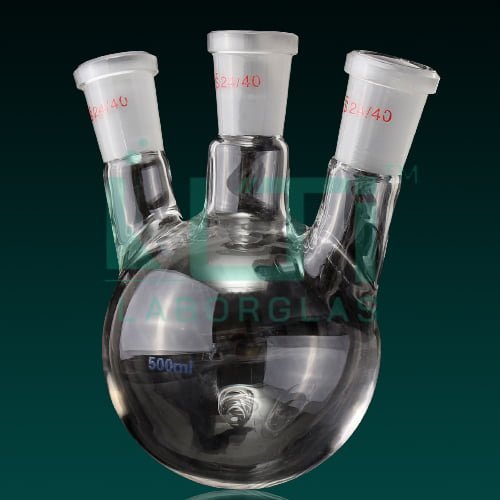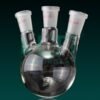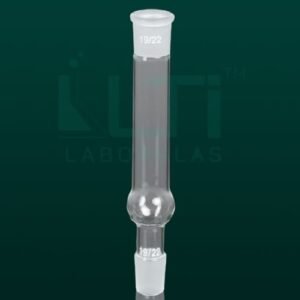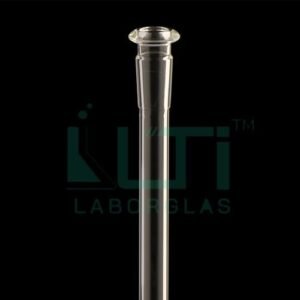- Made from ASTM E-438 Type 1, Boro 3.3 heat resistance glass
- Available with three neck angular
- Complies with ASTM & USP standard
| PART No. | Capacity (ml) | Centre Size | Socket Size | PACK Qty. |
| 5630-25 | 25 | 25 | 14/20 | 1 |
| 5630-50 | 50 | 50 | 14/20 | 1 |
| 5630-100 | 100 | 100 | 14/20 | 1 |
| 5630-100-A | 100 | 100 | 19/22 | 1 |
| 5630-100-B | 100 | 100 | 19/22 | 1 |
| 5630-100-C | 100 | 100 | 24/40 | 1 |
| 5630-250 | 250 | 250 | 14/20 | 1 |
| 5630-250-A | 250 | 250 | 19/22 | 1 |
| 5630-250-B | 250 | 250 | 24/40 | 1 |
| 5630-500 | 500 | 500 | 24/40 | 1 |
| 5630-500-A | 500 | 500 | 19/22 | 1 |
| 5630-1000 | 1000 | 1000 | 24/40 | 1 |
Here are some common uses for a 3-Neck Angular Round Bottom Flask in a laboratory:
- Multireaction Setups: The three necks enable the setup of multiple reactions in a single flask. This is particularly useful for parallel reactions or experiments involving different reactants or conditions.
- Distillation and Fractionation: The flask can be used in distillation setups where different fractions can be collected through the three necks. This is beneficial for fractionation processes or when multiple distillations need to be performed simultaneously.
- Refluxing and Addition of Reagents: One neck can be used for a reflux condenser, while the other two allow for the addition of reagents or other equipment. This configuration is suitable for reactions that require continuous reflux or the controlled addition of reactants.
- Simultaneous Sampling: The multiple necks allow for the simultaneous sampling of reaction mixtures at different time points or stages of the experiment.
- Temperature Control Experiments: One or more necks can be used for inserting thermometers or temperature probes, facilitating precise temperature control during reactions.
- Gas Inlet/Outlet: The necks can be used for introducing gases into the reaction mixture or for venting gases produced during the reaction.
- Complex Reaction Setups: The flask is ideal for creating intricate experimental setups involving various reaction components, monitoring devices, or other specialized equipment.
- Parallel Distillation: Similar to the use in reactions, the flask can be employed for parallel distillation, allowing researchers to simultaneously distill multiple samples.
- Solvent Removal and Evaporation: The flask can be used for solvent removal and evaporation processes, particularly when multiple solvents need to be removed simultaneously.
- Catalyst Addition: One or more necks can be utilized for the controlled addition of catalysts during reactions.







